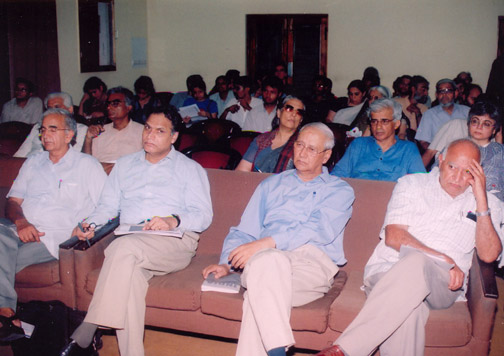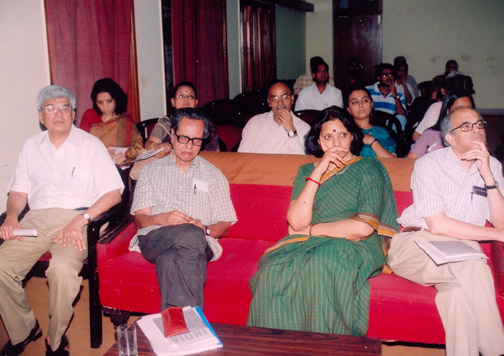Convention on Economics Social Scientist and SAHMAT
The vote against the NDA government in the recent elections was also a rejection of the neo-liberal economic policies that have been in vogue for the last thirteen years, and which the NDA in particular was pursuing relentlessly. The people’s verdict against neo-liberalism was scarcely surprising: the pursuit of these policies has led to a severe deflation of the economy, reducing the purchasing power of the rural population in particular; it has reduced per capita foodgrain absorption to levels prevailing at the beginning of the second world war; it has played havoc with the agrarian economy with extreme tangible consequences by way of mass suicides by farmers; it has greatly aggravated the problem of unemployment in both rural and urban India; and it has not only accentuated income inequalities but also handed over public assets to favoured private individuals at throwaway prices.
The Common Minimum Programme (CMP) of the new government, which recognizes the need for, and provides the outlines of, an alternative development trajectory, predictably, has aroused opposition from financial interests, which is one possible reason, among many, for the subdued state of the stock market. It is imperative, however, that the CMP is not impeded by the state of the stock market, which has hardly any bearing on the level of corporate investment, let alone on overall investment in the economy, and which attracts the participation of only a minuscule minority. Corporate investment, past experience indicates, would be stimulated by larger public expenditure. In addition, investment in the medium and small-scale sectors and in the infrastructural area must be supported by a renewed emphasis on development banking aiming to restore the role of investment demand as opposed to dominantly private, debt-financed consumption demand as the trigger for industrial growth. Once controls on capital flows into and out of the country are in place, which insulate the economy from the caprices of globalized finance, the stock market should be allowed to reach its own level while the CMP is implemented.
The additional resource mobilization that the implementation of the CMP, with its emphasis on reviving the agrarian economy and on putting in place an Employment Guarantee Scheme (EGS), would require, is well within the capacity of the economy. The EGS, for instance, can be financed and a balance left over, if only the Central government recaptures the Central tax revenue-GDP ratio that prevailed in the mid-1980s. Additionally, service sector taxation, asset taxation and taxation of financial transactions offer major revenue sources, as does the plugging of loopholes in the existing Income Tax laws. Besides, in a situation of demand constraint such as we have had, fiscal deficit, if judiciously used, need not be a cause for concern. The Fiscal Responsibility Act, which ties the hands of the government, is an illogical piece of legislation, especially when financial flows are relatively unrestricted -- it should be done away with.
Putting the EGS in place, however, would take time. Meanwhile, urgent succour has to be provided to the peasantry, which has been exposed to a double squeeze by the neo-liberal dispensation -- through decreased output prices and increased input prices, including of credit. A food-for-work programme must be started forthwith, particularly in areas of acute hunger and deprivation, and steps must be taken to universalize the public distribution system (PDS), which is an essential complement to the EGS. The government has announced certain steps for increasing institutional rural credit, but an immediate debt relief programme must be launched to stem the spate of peasant suicides that continue even now. Price support, sustained by appropriate protectionism, must be given to the peasantry forthwith. In addition, ways have to be devised to have a degree of social control over the pattern of land and water use, without which a serious crisis may emerge in the coming years.
The CMP cannot be implemented without strengthening the fiscal situation of the State governments, for which a complete write-off of non-Small Savings debt, and an interest rate reduction on Small Savings debt are essential. The exorbitant interest rates that the Centre has charged on its loans to States in the past must be done away with. The interest rate in the future must be discernibly below the average GDP growth rate. A transition to the VAT carries with it a serious threat to State finances and must be eschewed until its implications are examined in detail.
The social sector initiatives outlined in the CMP, as well as the promised affirmative action in the form of reservations for dalits in the private sector, must be taken up in right earnest. A more egalitarian society in which development is spearheaded by the growth of the home market stimulated by a dynamic agrarian economy must be our objective, not mere growth fetishism per se, nor leaving the task of development to the mercies of the world market, the whims of direct foreign investment or the caprices of globalized finance.
Some of the policy measures that need to be immediately undertaken are:
-
Immediate introduction of a food-for-work programme, especially in areas characterized by acute hunger.
-
Introduction of a universal PDS as a complement to the EGS.
-
Increase in Central Tax-GDP ratio for financing the EGS.
-
EGS to be integrated with plans for rural infrastructure development.
-
Tapping service taxation, asset taxation, taxation of financial transactions and taxation of forex use, and using such taxation differentially for serving a range of objectives.
-
Debt write-off for states on non-Small Savings debt. On Small Savings debt, lowering of interest rates through debt switching. All future interest rates on Central loans to be well below GDP growth rates.
-
VAT to be kept in abeyance until its implications are thoroughly studied.
-
Step up public investment in agriculture and other areas, and debt relief for farmers.
-
Extension of reservations for dalits to the private sector.
-
An increase in social sector expenditure to specific target levels.
-
Setting up a Commission to study social control over land and water use.
-
Rededication of a whole range of public financial institutions to development tasks through measures like divesting their current portfolios of debt through securitization.
-
Withdrawal of the Fiscal Responsibility Act.
BACK



